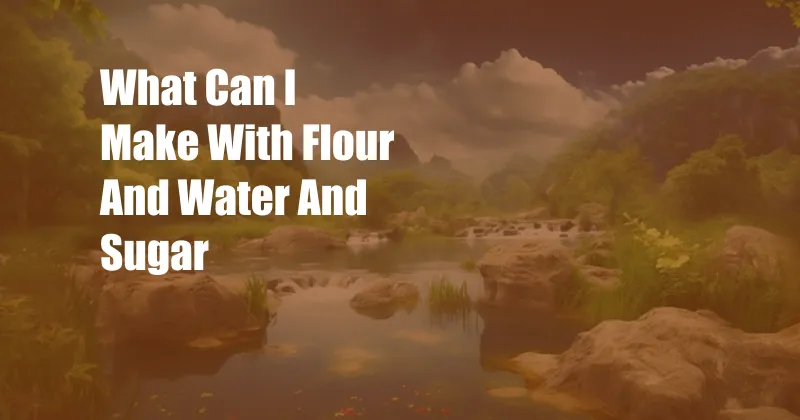
What Can I Make with Flour, Water, and Sugar?
Do you find yourself with a bag of flour, a jug of water, and a tub of sugar in your pantry, wondering what culinary wonders you can create? These three ingredients, when combined in different proportions and techniques, form the foundation of a surprisingly diverse range of dishes. From crispy pastries to soft and fluffy breads, let’s explore the boundless possibilities that await you in the world of flour, water, and sugar.
The Magic of Yeast: Unleashing a World of Breads
Yeast, a tiny living organism, holds the key to transforming a simple dough into a magnificent loaf of bread. When added to a mixture of flour, water, and sugar, yeast feasts on the sugars, releasing carbon dioxide gas as a byproduct. This gas gets trapped within the dough, creating countless tiny air pockets that give bread its characteristic lightness and texture.
The type of bread you create depends on the proportion of ingredients and the kneading technique. Kneading develops the gluten in the flour, creating a strong and elastic network that holds the dough together. For a classic loaf of white bread, simply combine flour, water, sugar, yeast, and salt. For more complex flavors and textures, experiment with different flours (whole wheat, rye, etc.) and add ingredients like herbs, spices, or even grated cheese.
Puff Pastry: A Masterpiece of Layers and Flakes
Puff pastry is an airy, flaky pastry that adds a touch of elegance to any dish. It consists of multiple layers of dough separated by thin layers of butter. As the pastry bakes, the butter melts and creates steam, causing the layers to puff up and separate, resulting in a crispy and light texture.
To make puff pastry, start by combining flour, water, and salt. Then, roll out the dough into a rectangle and spread cold butter over the surface. Fold the dough over itself several times, alternating between rolling and chilling, to create the intricate layered structure.
Choux Pastry: A Culinary Canvas for Creativity
Choux pastry, also known as pâte à choux, is a versatile dough that can be used to create a variety of treats, including éclairs, profiteroles, and beignets. It has a unique texture that is both light and airy, yet slightly chewy.
The secret to choux pastry lies in the way it is cooked. After combining flour, water, and butter, the dough is cooked over medium heat until all the moisture has evaporated. This process creates a dough that is strong enough to hold its shape when filled and baked.
Cookies: A Sweet Symphony of Flavors
Cookies are the quintessential treats that bring joy to people of all ages. With flour, water, sugar, and a variety of other ingredients, you can create a boundless range of cookie variations.
From classic chocolate chip cookies to chewy oatmeal cookies and crispy ginger snaps, the possibilities are endless. The key to creating the perfect cookie lies in balancing the ratios of flour, sugar, and fat. Different types of flour will result in different textures, while sugar and fat contribute to sweetness, tenderness, and chewiness.
Tips and Expert Advice for Culinary Success
- Use high-quality ingredients. The quality of your flour, water, and sugar will directly impact the taste and texture of your creations. Invest in good-quality ingredients for the best results.
- Measure your ingredients accurately. Baking is a science, and precise measurements are essential for success. Use a kitchen scale to ensure that you add the right amount of each ingredient.
- Knead your dough properly. Kneading develops the gluten in the flour, creating a strong and elastic dough that will result in a better texture.
- Don’t overmix your dough. Overmixing can toughen the dough and result in a dense, crumbly texture. Mix just until the ingredients are combined.
- Let your dough rest. Resting allows the gluten to relax and develop, resulting in a more tender and flavorful bread or pastry.
FAQ: Common Questions About Flour, Water, and Sugar
Q: Can I substitute water with milk or another liquid?
A: Yes, you can substitute water with milk, buttermilk, or even yogurt. However, using a liquid other than water may affect the texture and flavor of your baked goods.
Q: What is the difference between bread flour and all-purpose flour?
A: Bread flour has a higher protein content than all-purpose flour, which results in a stronger gluten network. This makes it ideal for breads that require a lot of kneading and rising, such as sourdough or French bread.
Q: Can I make gluten-free baked goods with flour, water, and sugar?
A: Yes, you can use gluten-free flour blends to create gluten-free baked goods. However, the texture may be different from traditional baked goods made with wheat flour.
Conclusion
The world of flour, water, and sugar is a vast culinary landscape, filled with endless possibilities for experimentation and creativity. From the fluffy heights of sourdough bread to the flaky layers of puff pastry, the sweet symphony of cookies to the versatility of choux pastry, these three ingredients are the cornerstones of countless culinary delights.
Whether you are a seasoned baker or just starting your culinary journey, I encourage you to explore the boundless potential of these essential ingredients. With a little bit of practice and the tips and advice shared above, you can unlock the secrets of flour, water, and sugar and create pastries and breads that will delight your taste buds and impress your loved ones.